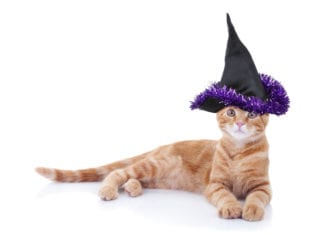Halloween safety tips for pets
By Matthew Kearns, DVM
Halloween is a fun time of dressing up in costumes and getting a whole bunch of free candy. I’ve even taken to dressing up Jasmine, our Labrador retriever, in new costumes every year. Here are a few tips to make sure this and every Halloween is a safe and happy one for your pets.
Candy and chocolate poisoning

Chocolate is dangerous for two reasons. First, it contains the chemicals caffeine and theobromine. Both of these are stimulants in the methylxanthine class. Halloween is one of the few times a large bowl of candies, many containing chocolate, would be left out. Signs usually begin within 6 to 12 hours after ingestion and include panting, hyperactivity, increased thirst and urination. Severe cases lead to irregular heart rhythms, seizures, coma and death. Second, chocolate is very high in sugar and fat. Most cases will only give your pet a tummy ache. However, I have personally seen a few cases of serious gastroenteritis (vomiting and diarrhea), pancreatitis and liver disease from ingestion of large amounts of chocolate and other candy.
Stomach and intestinal obstructions
Dogs and cats (especially young ones) are more likely to eat a costume than wear it. I have both seen and heard from colleagues pulling out portions of a witch’s nose, small scarecrow teddy bears, etc. Anything with stringy attachments or tinsel are potential obstructions for cats. Candy wrappers and packaging can become wadded up in the stomach or small intestines. Any of these items will cause intense pain and vomiting or avoidable (and expensive) surgery. As much as we want to make ourselves or the house look scary, please make sure to keep all things out of reach of curious pets.
Fears and phobias
Consult with your veterinarian if your pet is afraid of loud noises or many people coming to the door. There are a few cases where we have instituted anti-anxiety medications weeks before Halloween. However, many times a mild tranquilizer is all that is needed for the single holiday. Always have your pet examined by the veterinarian (especially older pets) before administering these medications.
Malicious injuries
Make sure your pets (especially with cats that go outside) are in for the night early. Unfortunately, we do see malicious acts toward animals increase on this particular holiday. I hope this information is helpful in providing a safe Halloween environment for our pets.
Dr. Kearns practices veterinary medicine from his Port Jefferson office.







